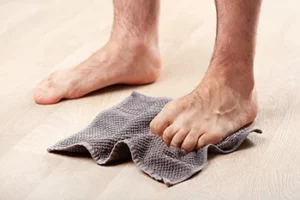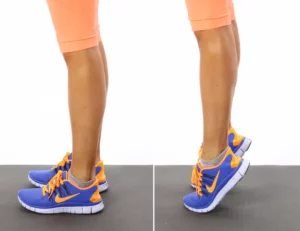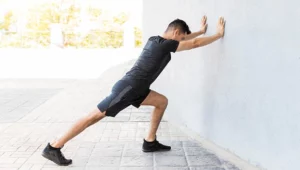Ever taken a look at the mirror’s reflection of your feet and noticed a lack of that distinctive curve on the underside? You’re not alone. Many of us with flatter feet have often shrugged it off as a harmless quirk. But what if those flattened arches were secretly plotting against your knees, orchestrating every twinge and ache you feel as you go about your day? It’s a question that’s not only puzzling but also concerning for many: “Is my flat feet the silent culprit behind my nagging knee pain?” Dive in as we unravel this connection and shed light on simple exercises and treatments that can guide you towards relief.
Contents
Can Flat Feet Cause Pain in Your Knee?
 The foundation of our body is our feet, and just like a building’s foundation, if there’s a misalignment at the base, the structures above can be impacted. When you have flat feet, the lack of arch support can lead to an altered walking pattern, which in turn, can affect the alignment and forces exerted on the knee.
The foundation of our body is our feet, and just like a building’s foundation, if there’s a misalignment at the base, the structures above can be impacted. When you have flat feet, the lack of arch support can lead to an altered walking pattern, which in turn, can affect the alignment and forces exerted on the knee.
The Biomechanics Behind the Pain
When you possess a flattened foot arch, it leads to overpronation, meaning your foot rolls inwards more than the usual when walking or running. This excessive inward roll causes the tibia (shinbone) to twist inwards, which in turn, can lead to malalignment of the knee joint. This misalignment causes an uneven distribution of weight and forces across the knee, leading to increased stress on certain parts of the joint and, ultimately, pain.
While flat feet might not be the sole reason for your knee discomfort, it’s undeniable that it plays a significant role. Recognizing this connection is the first step in seeking the right interventions and ensuring the health of your knees and overall posture.
Common Symptoms of Knee Pain from Flat Feet
 Flat-footedness doesn’t just affect the feet; its ripple effects can be felt up the legs, especially in the knees. For those with flat feet, there are several tell-tale signs in the knees that hint at this underlying condition. Let’s delve into the most common symptoms of knee pain attributed to flat feet and understand their connection:
Flat-footedness doesn’t just affect the feet; its ripple effects can be felt up the legs, especially in the knees. For those with flat feet, there are several tell-tale signs in the knees that hint at this underlying condition. Let’s delve into the most common symptoms of knee pain attributed to flat feet and understand their connection:
- Inner Knee Pain:
- Connection to Flat Feet: With flat feet, there’s a tendency for the foot to roll inwards, a condition known as overpronation. This causes the inner knee to bear more weight and stress, leading to pain in that area.
- Swelling Around the Knee:
- Connection to Flat Feet: The misalignment caused by flat feet can lead to increased friction and pressure within the knee joint. This can result in inflammation and swelling.
- Stiffness After Resting:
- Connection to Flat Feet: An imbalanced gait due to flat feet can lead to uneven wear and tear on the knee. This can cause the knee joint to stiffen after resting.
- Instability When Walking or Turning:
- Connection to Flat Feet: The knee may overcompensate for the foot’s lack of arch support and proper alignment, leading to feelings of instability.
- Clicking or Popping Noises:
- Connection to Flat Feet: Due to the changed biomechanics and altered gait from flat-footedness, the knee’s patella (kneecap) may not glide smoothly, causing these noises.
- Worsening Pain with Activity:
- Connection to Flat Feet: As flat feet often result in an altered gait, repetitive activities exacerbate the imbalances, leading to increased knee pain.
Understanding these symptoms and their link to flat-footedness is crucial. It empowers individuals to take the necessary steps in seeking timely medical advice and interventions to prevent further complications.
Strengthening and Stretching: Exercises to Combat Knee Pain from Flat Feet
Flat feet can indirectly contribute to knee pain by causing imbalances in the body’s biomechanics. Addressing these imbalances with targeted exercises can alleviate the associated discomfort. Here are some effective exercises designed to tackle the root cause of knee pain arising from flat feet:
Arch Lifts

- How to Do It:
- Stand with feet hip-width apart.
- Keep heels on the ground, and try to lift the arches of your feet.
- Hold for a few seconds, then release.
- Repeat 10-15 times.
Towel Scrunches

- How to Do It:
- Sit on a chair with a towel spread out in front of your feet.
- Use your toes to scrunch the towel toward you.
- Repeat 10-12 times.
Heel Raises

- How to Do It:
- Stand with feet hip-width apart.
- Raise your heels, putting weight on the balls of your feet.
- Lower your heels back down.
- Repeat 15-20 times.
Ankle Inversion and Eversion

- How to Do It:
- Sit with legs outstretched.
- Turn your feet inward (inversion) and then outward (eversion).
- Do this movement 10 times in each direction.
Calf Stretch

- How to Do It:
- Stand facing a wall with hands on it.
- Step one foot back, keeping its heel on the ground.
- Bend the front knee until a stretch is felt in the back leg’s calf.
- Hold for 20-30 seconds, then switch legs.
Quadriceps Stretch

- How to Do It:
- Stand on one leg, holding onto a wall or chair for balance.
- Grab the ankle of the other leg, pulling it towards your buttocks.
- Hold the stretch for 20-30 seconds, ensuring your knees are together.
- Switch to the other leg.
Incorporating these exercises into your daily routine can make a significant difference in managing knee pain caused by flat feet.
Treatments For Relieving the Pain
While exercises and physical therapy play a crucial role in managing the pain arising from flat feet, other treatments can also offer significant relief. Here’s a comprehensive guide to home remedies and treatments for alleviating discomfort related to flat-footedness and associated knee pain:
1. Orthotics and Arch Supports: Custom-made orthotics or over-the-counter arch supports can correct the flat foot arch, distributing weight more evenly and alleviating strain on the knee.
2. Supportive Footwear: Shoes with proper arch support and cushioning can prevent further flattening of the arch and provide much-needed comfort.
3. Rest and Elevation: If the pain becomes too intense, it’s essential to give your feet a break. Elevate your feet to reduce swelling and avoid activities that aggravate the pain.
4. Ice Packs: Applying cold compresses or ice packs to the sore area can help reduce inflammation and provide immediate relief. Ensure there’s a cloth barrier between the ice and your skin to prevent frostbite.
5. Over-the-counter pain relievers: Non-prescription medications like ibuprofen or naproxen can help reduce inflammation and pain. However, always follow the recommended dosage and consult with a healthcare professional if unsure.
6. Weight Management: Maintaining a healthy weight can reduce the strain on your feet and knees, decreasing the risk of pain related to flat feet.
8. Ankle Braces: If the pain extends to your ankle due to flat feet, using ankle braces can provide support and reduce discomfort.
10. Surgical Interventions: In severe cases where non-surgical treatments don’t offer relief, surgical procedures like tendon transfers or bone fusions might be recommended.
Always consult with a healthcare professional to get a proper diagnosis and a tailored treatment plan. Combining multiple treatments, like wearing orthotics while following a physical therapy routine, can offer more comprehensive relief.
Conclusion
Flat feet may appear benign, but their ripple effect on our biomechanics can be profound, especially when it comes to knee pain. Recognizing the connection and taking proactive measures can make a world of difference in comfort and mobility. Remember, every foot and every knee is unique, and so are its needs. Tailored solutions, especially with the guidance of professionals, can bring about lasting relief. If you’re currently grappling with knee discomfort, don’t wait for the pain to escalate. Physical therapy for knee pain at PhysioMantra is at your beck and call. Book an online physical therapy session today and stride towards a pain-free tomorrow.



